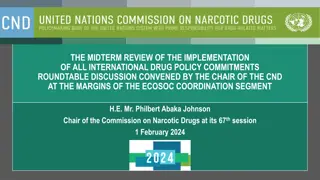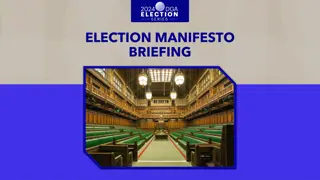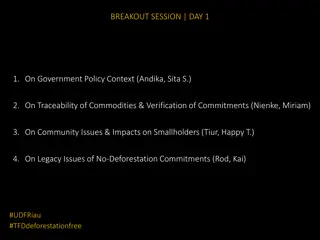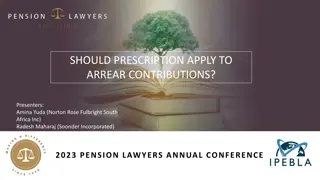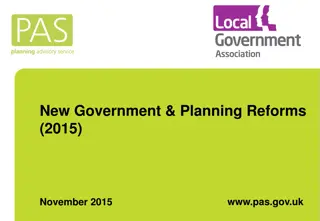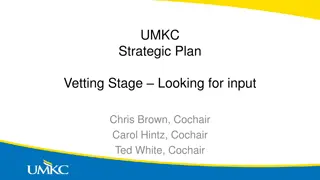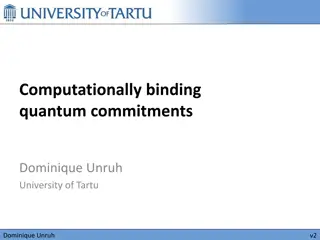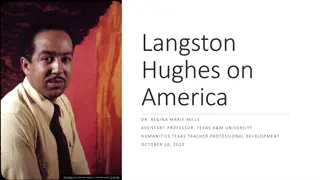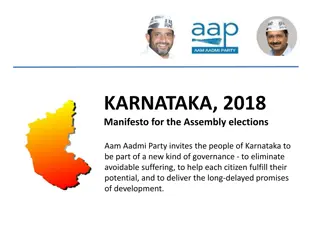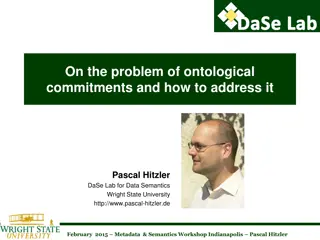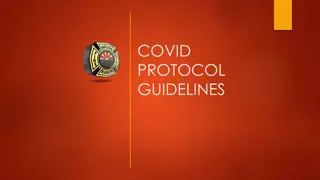
Ministry of Local Government's Contributions to NRM Manifesto Commitments
Ministry of Local Government's efforts in strengthening decentralization for efficient public service delivery, operationalizing new districts, and enhancing local council courts for effective governance.
Download Presentation

Please find below an Image/Link to download the presentation.
The content on the website is provided AS IS for your information and personal use only. It may not be sold, licensed, or shared on other websites without obtaining consent from the author. If you encounter any issues during the download, it is possible that the publisher has removed the file from their server.
You are allowed to download the files provided on this website for personal or commercial use, subject to the condition that they are used lawfully. All files are the property of their respective owners.
The content on the website is provided AS IS for your information and personal use only. It may not be sold, licensed, or shared on other websites without obtaining consent from the author.
E N D
Presentation Transcript
1.0 Introduction. 1.0 Introduction. 2.0 Detailed Actions undertaken towards Manifesto Commitments by the Ministry. 2.0 Detailed Actions undertaken towards Manifesto Commitments by the Ministry.
This presentation is an account of what the Ministry of Local Government has contributed with regards to implementation of NRM manifesto commitments as well as realization of the 23 strategic Guidelines.
2.1: Strengthening decentralization to ensure effective and efficient public service delivery Strengthening decentralization to ensure 2.1: effective and efficient public service delivery In FY 2017/18, staffing levels for critical positions in the Local governments improved to 54% as compared to 45% in FY 2015/16 and currently staffing stands at 56% as of March, 2019.
In FY 2015/16, in response to peoples demands Government created 23 Districts which were operationalized in a phased manner as follows: In FY 2016/17 Rubanda and Omoro were operationalised. FY 2017/18, Butebo, Rukiga kyotera and Bunyangabu districts were operationalized. . In FY 2018/19 kasanda Kapelebyong, and Kikuube were operationalized While in FY 2019/20, Karenga, Obongi, Kalaki, Kitagwenda, Kazo and Madi-Okollo will commence. In FY 2016/17 the Districts of Kagadi Kagadi, Kakumiro FY 2017/18, the Districts of Namisindwa Namisindwa, Pakwach, In FY 2018/19 the Districts of Nabilatuk Nabilatuk, Kwania, FY 2019/20, the Districts of Rwampara Rwampara,
Following the election of Village and Parish councils that also constitute local council courts, the structure is now fully constituted at all the three levels including the Sub County/ Town council/Division. To ensure efficient coordination of the performance of the structure, the Ministry has established local courts desk offices in 110 LGs (Districts and MCs). Training of the Local Council III courts were conducted in 2016 and the Ministry is currently conducting Barazas for village and parish Local Councils to discuss key principles , rules and procedures on how to conduct court business at that level. In addition, the Ministry has supported the functioning of these courts with training interventions, requisite guidelines/manuals and the necessary tools.
The Ministry has held quarterly meetings with Chief Administrative Officers and Town Clerks. In addition, various meetings were held for District Heads of Departments including District Planners and Chief Finance officers, District production officers, District Engineers, District Education and District Commercial Officers, principal human resource officers, Mayors of Municipalities and town clerks, District health Officers, Chairpersons of district service commissions, and their secretaries, to ensure efficiency of local governments.
Government Chairpersons in 2017 in line with its mandate and commitment in the NRM Election Manifesto to facilitate LG officials with transport equipment. In the current FY 2018/19, the Ministry is procuring vehicles for District Chairpersons of sixteen new Districts of Kagadi, Kakumiro, Omoro, Butebo, Pakwach, Kyotera, Nabilatuk, Bugweri, Kasanda, Kwania, Kapelebyong, and Kikuube. The Ministry is in the process of procuring 2000 Motorcycles for Sub County; Division inspect and monitor government programs and projects. The Ministry is engaging MoFPED to provide funds for procurement of Motorcycles to sub county chiefs and bicycles for parish chiefs following a Presidential directive. procured 111 vehicles for District Rubanda, Rukiga, Bunyangabu, Namisindwa, Town Council Chairpersons to enable them
Conducive working environment Availability of conducive working environment is important for ensuring administrative efficiency and management of the delivery of public services by LGs. Whereas in FY 2017/18, the Ministry offered financial support to 35 LGs which were constructing their own headquarters. In FY 2018/19 the Ministry is supporting 14 Local Governments. Conducive working environment:
Human resource Management With regard to the recruitment of personnel at Lower Local Governance levels, there have been deliberate efforts to fill the vacant posts and provide skills enhancement support to the officials. Since FY 2017/18, the Ministry of Local Government prioritized recruitment of Sub- County and Parish Chiefs, in the interest of enhancing visibility of government amongst the people, to ensure effective accountability, monitoring and reporting on Government programmes. In the Financial year 2017/18, staffing was 62% and 78% for Parish Chiefs and Sub-County Chiefs respectively. Human resource Management:
The Parish Chiefs have particularly been tasked to mobilise community members to participate in Monitoring Government programmes and projects, sensitise communities on the importance of Group formation; create and maintain a Register of all individuals that have benefitted from Government interventions, Follow up on school enrolment and drop-outs, follow-up and report on Primary Health care activities; and monitor programme implementation to ensure attainment of intended objectives.
Upon conclusion of the General Elections, the Ministry conducted a comprehensive induction exercise aimed at equipping Councilors with knowledge and skills on how to carry out their roles and responsibilities. In this regard by end of April, 2019, the Ministry had conducted induction of Councilors in 82 Districts out of 127 and is in the process of covering the remaining 45 before the close of this FY.
Adequate financing of LGs is critical for ensuring service delivery to the people. Over the years, there has been an increase .Progressively, in FY 2017/18 UGX 2.7trilion was allocated to Local Governments and allocation has increased to UGX 3.1trillion in FY 2018/19, and to UGX 3.4trillion in FY 2019/20. This increase reflects Government s commitment to ensure optimal financing for decentralized service delivery. In a bid to expand the domestic tax base, without necessarily increasing tax rates, the sub-sector has commenced on the automation of local revenue administration in Local Governments.
Regional development initiative to improve local revenue generation The Ministry has also embarked on the preparatory process for implementing the Presidential Initiative for Agro-Industrialization for Local Economic Development (Agri-LED) which is a transformative national initiative, with the overall strategic agenda of transforming the local government financing system through effective business related Local Economic Development. The Programme focuses on poverty reduction and sustainable wealth creation, as guided by the Local Economic Development (LED) Policy, 2014. The first phase of this initiative will be cover Rwenzori sub region and it will cost 714Bn. This initiative will be replicated in other regions. This strategy will tap the different potentials and natural endowments for locality development purposes. Regional development initiative to improve local revenue generation
Design of the fiscal decentralization architecture Under this strategy, a new allocation formular was designed to ensure fair allocation of grants to LGs. In addition, negotions with sectors have been conducted to inform the sectors grant guidelines and budget allocations to the LGs. Design of the fiscal decentralization architecture
Restructuring of MOLG The staffing structure of the ministry has been reviewed and approved by ministry of public service within which a new department of LED has been created to coordinate the implementation of the LED strategy. Restructuring of MOLG
Following the completion of the first phase of construction of seven markets which ended in 2015, the ministry has embarked second Phase of the Project, (MATIP-2), in 12 Municipalities, namely: Arua, Busia, Entebbe, Kabale, Kasese, Kitgum, Lugazi, Masaka, Mbarara, Moroto, Soroti and Tororo. Over 20,000 vendors in the above 12 markets are expected to be resettled back upon completion. The ministry is also constructing two value addition facilities in Busia and Arua Muncipalities and the procurement for the third one in Soroti is under way. Similarly, under the Urban Markets and Marketing Development of the Agricultural Products Project (UMMDAP). Nyendo Market in Masaka was constructed and about 755 vendors were relocated back. Busega Market in Rubaga Division is still under construction. Once Busega Market is completed, it will accommodate 1644 Vendors.
As part of the overall effort to fast track Uganda into a middle income status, Government has approved creation of 15 cities , and their operationlaisation is phased as follows: FY 2020/21- Arua, Mbarara, Fort Portal, Gulu and Jinja. FY 2021/22-Homa, Mbale FY 2022/23-Lira,Entebbe FY2023/24- Nakasongola,Moroto,Masaka,Soroti,Kabale,Wakiso
Government has implemented dedicated interventions aimed at enhancing affirmative action for Northern Uganda. Currently, the Ministry through 9 LGs is implementing a specific programme called PRELNOR whose development objective is: increased sustainable production, productivity and climate resilience of small holder farmers with increased and profitable access to domestic and export markets. The project is being implemented in a total of nine districts, of Agago, Amuru, Gulu, Lamwo, Kitgum, Nwoya and Pader in the Acholi sub-region together with the adjoining district of Adjumani, which has similar agro- ecological conditions to Amuru and Nwoya districts. PRELNOR is constructing 608Km of Community Access Roads (CARs) in FY 2018/19 and another 950Km will be constructed next financial year. Designing of 11 Produce markets is on-going and construction of the markets will commence next financial year. Furthermore, 120 Motorcycles, 11 vehicles and 400 Bicycles were bought and given to the District Local Governments to support extension services.
To this end, the Ministry has already realized 62% of NRM Manifesto Commitments and remains committed to achieving 100% by completing the construction of Markets, improving staff levels, conducive environment and scaling up the resources transferred to LGs. Thank you for Listening Thank you for Listening

